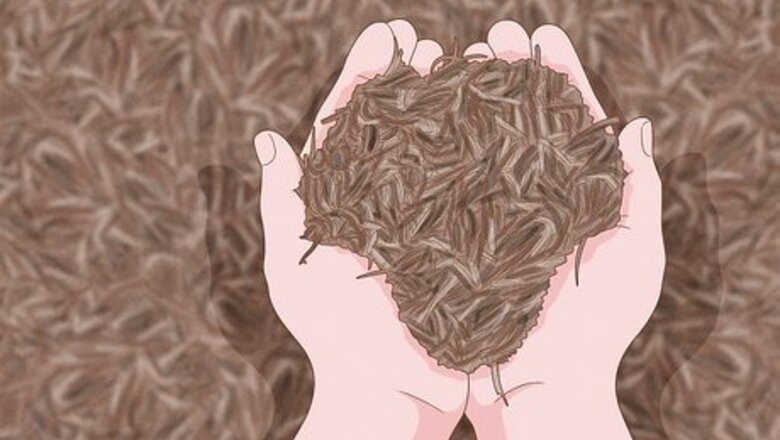
views
Choosing a Mulch
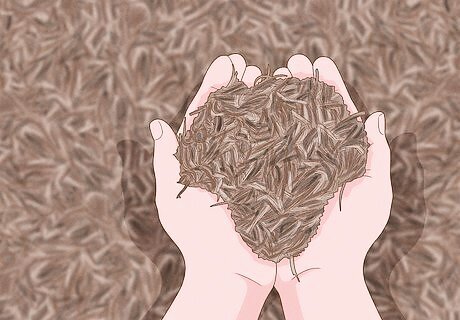
Purchase good quality, properly processed mulch. Always use a good quality mulch that has been properly processed. Mulch made from diseased or insect-infested trees can spread the disease or insects to your hydrangeas. Therefore, mulch must be composted properly to eliminate these potential hazards. Shredded bark mulch or bark chunks sold in bags at garden centers are the safest option, but many companies that sell bulk mulch also offer a good quality product. Bagged mulch at garden centers should state right on the bag that the mulch has been composted or sterilized. If you are buying mulch in bulk, make sure to ask the company for their assurance that the mulch has been properly processed. If there are huge, steaming piles of mulch at the bulk mulch yard and large equipment used for turning the mulch, this is a good indication that the mulch has been properly composted.

Use an acidic mulch for blue hydrangeas. It is possible to encourage hydrangeas to bloom in your preferred color - pink or blue - by altering the acidity level of the soil. Blue hydrangeas prefer acidic soil, while pink hydrangeas need a more alkaline soil. Therefore, using an acidic mulch will alter the pH of the soil and support the growth of blue hydrangeas. Spent coffee grounds make a good ‘acid’ mulch – ask your local café if you can take a bag of theirs. They usually throw their coffee grounds away, so this shouldn't be a problem. Other suitable acidic mulches include sphagnum peat moss, pine needles (also known as ‘pine straw’), shredded or chipped pine bark (also known as ‘pine bark nuggets’), or similar mulches made from cypress or eucalyptus.
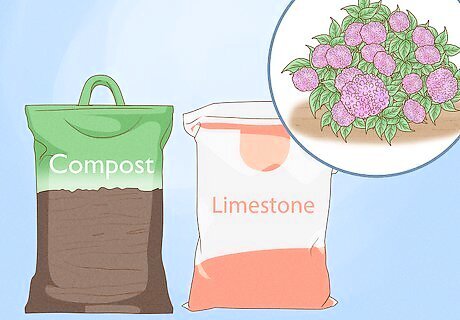
Try a neutral or alkaline mulch for pink hydrangeas. Alkaline soil is necessary to produce pink hydrangeas, however it is harder to find alkaline mulches. Therefore you may need to use a combination of neutral mulches and alkaline dressings in order to produce pink flowers. Try applying a neutral pH mulch (such as regular compost) to the soil surrounding your hydrangeas. This will not make the soil more alkaline, but it will not make it more acidic either. To boost the alkaline properties of the soil, try adding a dressing of ground limestone or chalk on top of the neutral mulch. Alternatively, you can use a slightly alkaline mulch such as the shredded or chipped bark from hardwood trees. Unfortunately this type of mulch isn't alkaline enough to significantly change the pH level of the soil, so you will still need to use one of the alkaline dressings mentioned above.

Experiment with mulches such as sawdust or pine needles to deter pests. Mulch can be a good barrier to protect your hydrangeas from pests such as slugs and snails. The best mulches for deterring these pests are sawdust or pine needles, as the slugs and snails cannot travel across these types of surfaces. An alternative to using these mulches would be to apply a layer of pest-deterring material over the top of a regular mulch. Such pest-deterring materials include crushed egg shells, finely crushed nut shells, a thin layer of ash or cinders or even a layer of human hair clippings. These materials can be placed around the base of the hydrangeas, on top of the existing mulch.
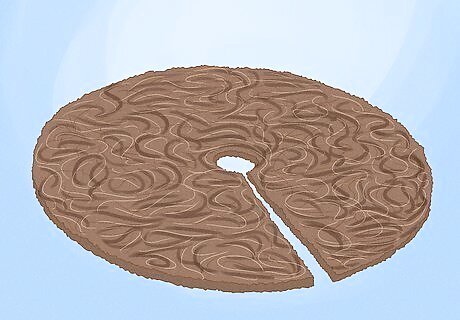
Purchase a mulch mat to maintain the pH level of the soil. Using a mulch mat is a good idea if you want all of the benefits of a good mulch, without altering the pH level of the soil. A good mulch mat will allow rainwater to permeate the ground whilst keeping weeds at bay and heat in the soil, which will greatly benefit your hydrangeas. However, mulch mats won't break down like regular mulch (unless you purchase biodegradable ones) so the pH of the soil won't be affected by the mat. If you dislike the appearance of mulch matting, consider covering it with a layer of organic material such as bark chips. Mulch mats tend to be especially useful when planting a completely new bed. Follow manufacturer’s instructions for further information on using mulch mats.
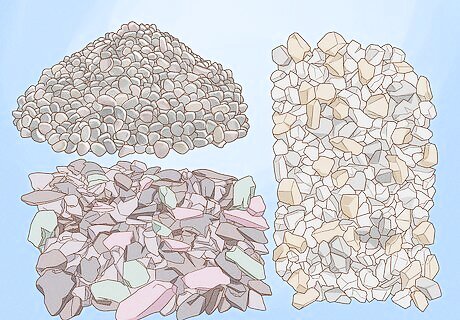
Use inorganic mulches for decorative purposes. While organic mulches will break down and affect soil acidity, some gardeners prefer to use inorganic mulch materials such as slate, stone or gravel. These are more expensive than organic mulches (such as leaf mold) but tend to last longer and give a neat, decorative finish to your flower bed. It’s unusual to have to top up or replace inorganic mulches such as gravel, so less maintenance work is required than for organic mulches. However, inorganic mulches may be slightly harder to apply in the first place. In addition to their aesthetic appeal, inorganic mulches have the added benefit of not smelling bad, as some organic mulches do.
Applying the Mulch

Do all of your mulching in springtime. You should aim to apply your chosen mulch to the hydrangea bed in springtime (though the timing isn't overly important). Mulching the hydrangeas in spring will help to retain moisture in the soil over the dry summer months, which will prevent you from needing to water the flowers as frequently. You should avoid mulching in the wintertime as this causes the soil to retain cold, which is bad for the plants.
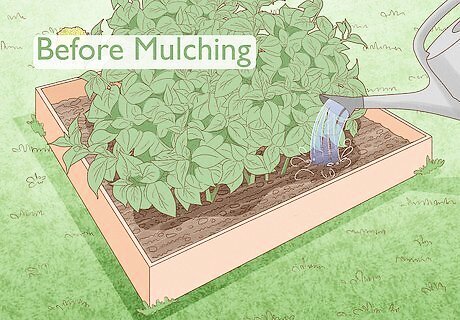
Water the hydrangeas before you apply the mulch. Before you apply the mulch, you should remove any weeds from the flower bed and give them a good watering. This prevents the soil from drying out or becoming clogged with weeds beneath the mulch.
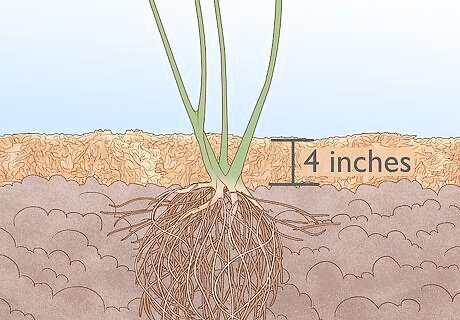
Apply a layer of mulch approximately four inches deep. For best results, you should apply a relatively thick layer of mulch, approximately four inches deep. As a general rule, finer-textured mulches - such as sawdust - should be applied less thickly (about 3 inches depth) than ones with thick chunky pieces. Larger-textured mulches - such as bark chips - may be applied to a depth of about 5 inches (12.7 cm).

Keep the mulch 3 to 6 inches (7.6 to 15.2 cm) away from the stems. Keep the mulch 3 to 6 inches (7.6 to 15.2 cm) away from the stems of your hydrangeas. If the mulch is right up against the stems, it encourages dampness, which can lead to root rot. It could also encourage rodent activity during the winter and subsequent stem damage from the rodents.
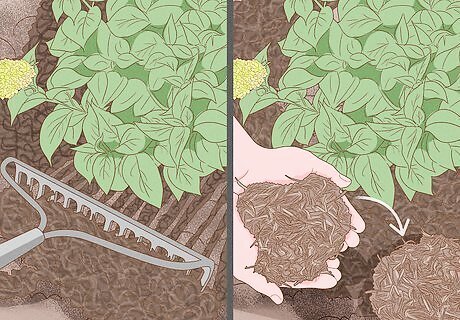
Apply new mulch each year. You should replenish the mulch around the hydrangeas every year, in order to keep it fresh. Do not just pour new mulch over the old - use a garden fork, dirt shovel or rake to loosen and turn the old mulch. This will prevent the mulch from becoming too compacted, which restricts water and air movement. Add new mulch to the old mulch to bring the total depth up to between 3 and 5 inches.
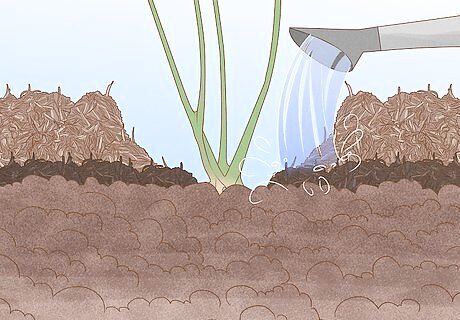
Remember to water your plants more generously after mulching. Remember that your hydrangeas will require a bit more water after mulching, because the thick mulch layer will absorb some water before it reaches the roots. Therefore you will need to provide more water to prevent the roots from drying out.




















Comments
0 comment